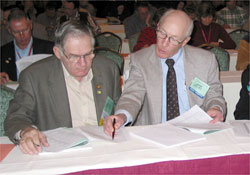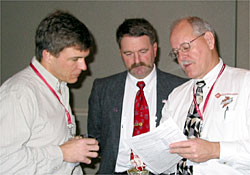

 |
| Genetics for Cowboys attendees worked in groups. They were given a case study, then asked to select bulls to meet the genetic needs of the operation. |
 |
| Darrh Bullock, Mark Gardiner and Daryl Strohbehn discuss the case study before a general discussion with all attendees. |
7: 30 a.m.– 9:15 a.m.
PR 101 – Genetics For Cowboys - Darrh Bullock, University of Kentucky; Mark Gardiner, Kansas; Daryl Strohbehn, Iowa State University, Norman Voyles, Jr., Indiana
Audio File — Introduction, Case Study I discussion and explanation of Case Study II
Audio File — Case Study II discussion
You will need Windows Media Player to listen to audio archives of the presentations.
Click here to download a free version.
Strengths/Weaknesses Scoring Tool
Do your homework before heading to the sale
Beef producers have a lot of options when buying bulls. Presenters at the Genetics for Cowboys session during Cattlemen’s College Wednesday, Jan. 29, stressed the importance of being prepared before traveling to a bull sale. They walked participants through the steps to take at home to be sure you select a bull that will fit your program’s goals.
Cattlemen’s College, which is sponsored by Pfizer Animal Health, is an educational forum held in conjunction with the 2003 Cattle Industry Convention and Trade Show in Nashville, TN.
The session focused on the importance of looking at your cow herd and evaluating its strengths and weaknesses before starting the search for your next herd sire. Daryl Strohbehn lead the group through a "Strengths/Weaknesses Scoring Tool" that producers can use to evaluate their herd. When going through the process he said it is important to determine, "What are the three big items that your herd should concentrate on during the next two to four years?"
Following the explanation of the scoring tool producer panelists Mark Gardiner and Norman Voyles walked through the selection process of purchasing a bull to fit a case study herd. (The case study and sale book utilized in the discussion will be posted to this site by Feb. 15.)
"To make a directional change in any trait you need to select a bull in the upper EPD (expected progeny difference) percentile," Gardiner explained. He also reminded participants about the differences among EPDs of different breeds.
Voyles explained to participants that young bulls don’t have as high of accuracy levels as mature bulls, so when he selects young, unproven bulls he looks for a range of EPDs.
After walking though the scenario, Strohbehn reminded participants that it is important to not make drastic changes in your breeding program based on one year of data and to select genetics that fit your environment.
The remainder of the session was devoted to the participants working through a second case study in groups and discussing why they selected the bull(s) they did.
Please revisit this site in the next week for more information about this session.
-- by Angie Stump Denton